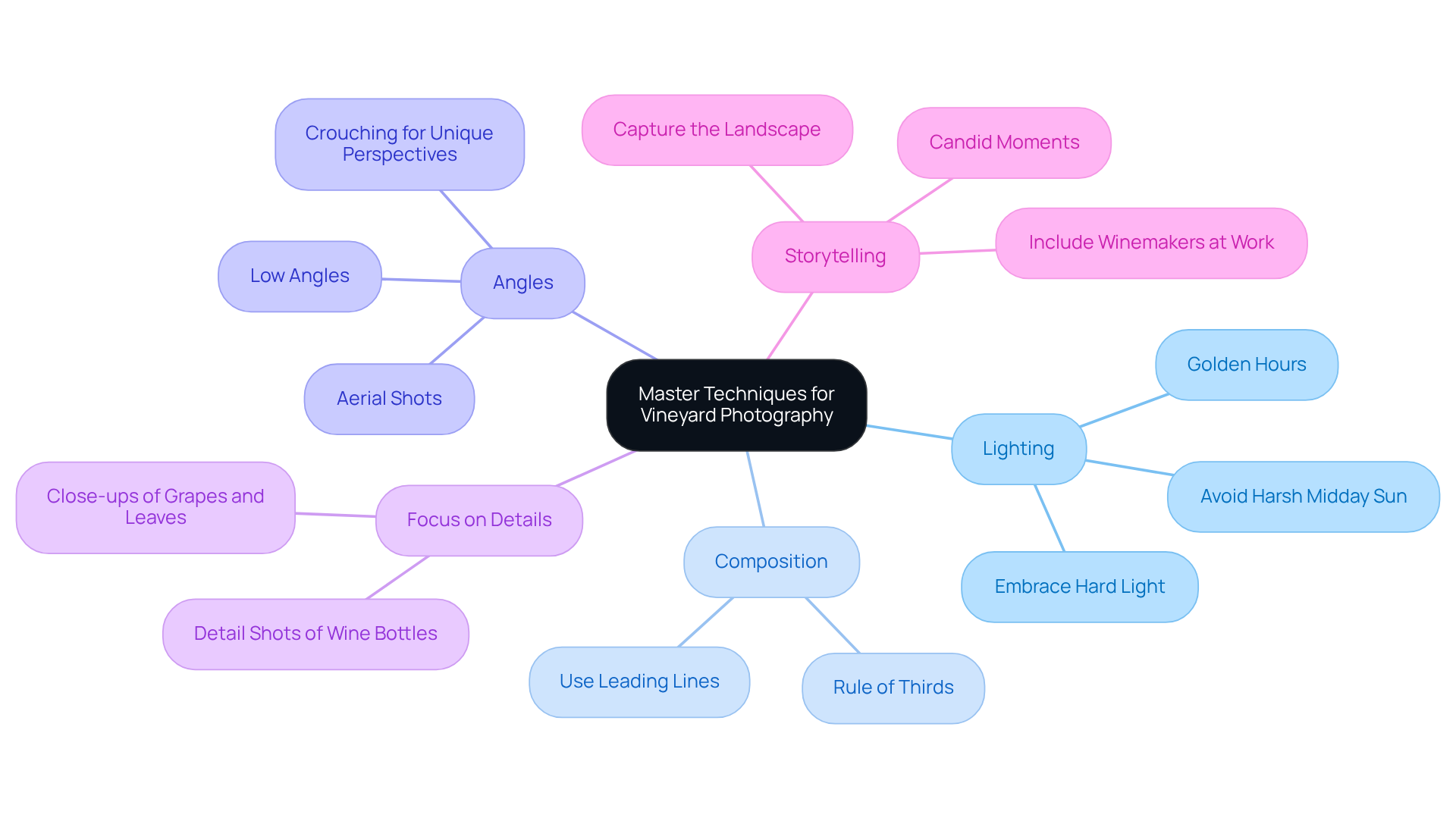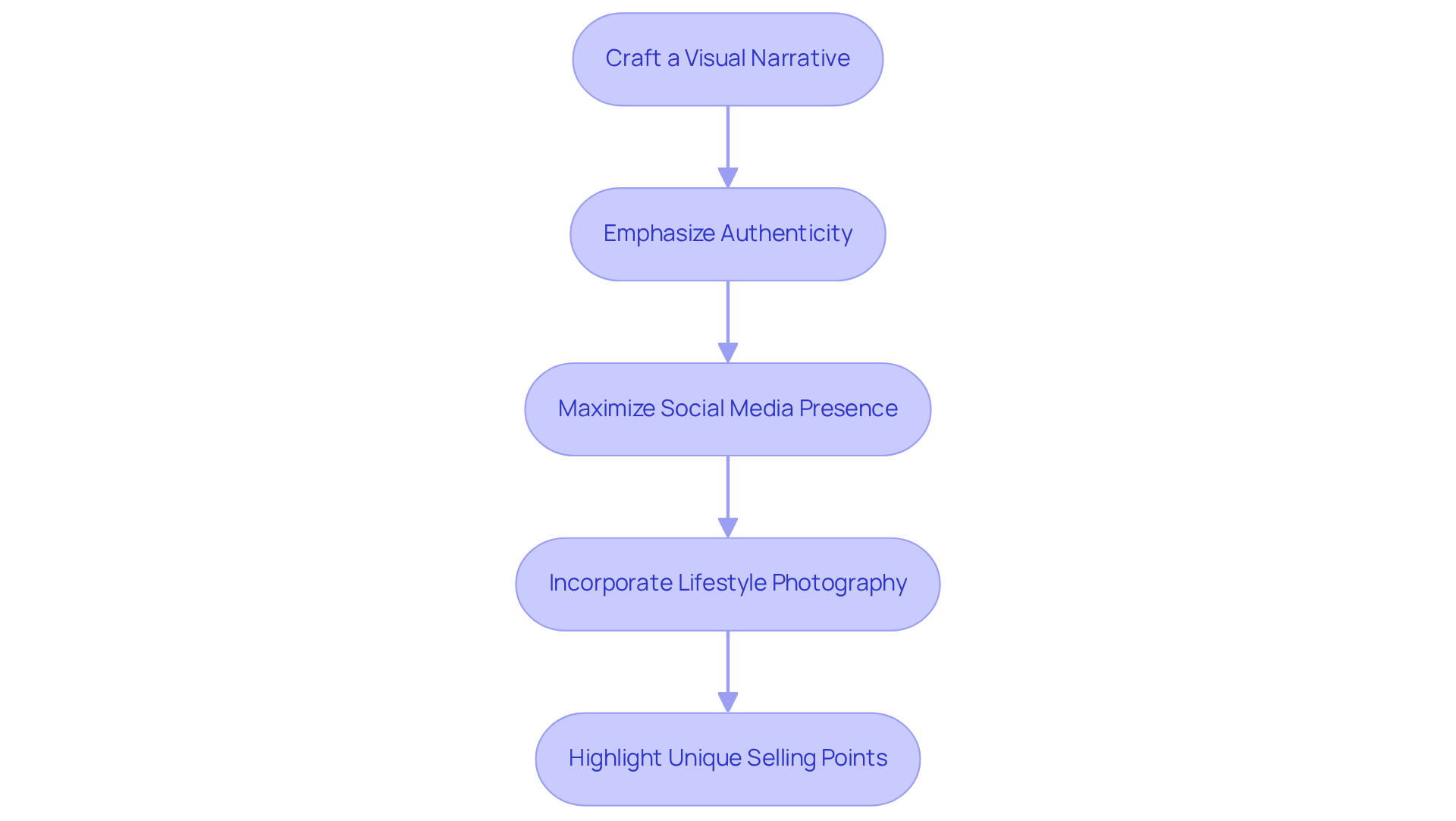Overview
Vineyard photography is crucial for marketing success, as it effectively communicates a winery's brand narrative and engages consumers, ultimately driving sales and fostering customer loyalty. High-quality images evoke emotions and enhance online presence.
By employing techniques such as effective lighting, composition, and storytelling, wineries can significantly elevate the impact of their visuals in a competitive market. This strategic approach not only captivates potential customers but also reinforces brand identity, making it an indispensable tool for success in the wine industry.
Introduction
Vineyard photography transcends mere picturesque landscapes; it serves as a pivotal element in effective wine marketing, capable of transforming casual buyers into devoted fans. By leveraging striking visuals, wineries can create compelling narratives that resonate profoundly with consumers, thereby enhancing brand identity and driving sales. Yet, in a marketplace teeming with vineyards vying for attention, what key techniques can elevate vineyard photography from the ordinary to the extraordinary? This inquiry not only underscores the importance of visual storytelling but also prompts a deeper exploration into the strategies that can distinguish a winery in a crowded field.
Understand the Role of Photography in Vineyard Marketing
Vineyard photography serves as a powerful tool in wine marketing, enabling producers to visually articulate their brand narrative and principles while enhancing direct-to-consumer (DTC) strategies. High-quality visuals evoke emotions, showcase the charm of wineries, and highlight the artistry behind each bottle, effectively transforming casual purchasers into loyal club members.
By recognizing the importance of vineyard photography, vineyards can create compelling visual narratives that resonate with consumers, ultimately driving engagement and sales. For instance, images depicting lush grape-growing regions during harvest can evoke nostalgia and a connection to the land, thereby increasing the likelihood that consumers will choose that producer's products over competitors.
Furthermore, effective vineyard photography bolsters online presence and supports strategic capital planning, making it crucial for wineries to invest in vineyard photography to distinguish themselves in a competitive market. Engaging visuals lead to longer website visit durations and significantly enhance conversion rates, underscoring the necessity of a strategic approach to visual storytelling in wine marketing.
As Caroline Kenyon, founder of the World Food Photography Awards, aptly states, "Images possess a unique power to convey the craftsmanship, passion, and tradition of winemaking, as well as the bond between wine and those who produce and savor it.
Master Essential Techniques for Capturing Stunning Vineyard Images
To capture stunning vineyard images, it is essential to employ effective techniques:
- Lighting: Harness natural light, particularly during the golden hours—early morning or late afternoon—to produce gentle, captivating photographs. As Roberto Valenzuela suggests, embracing hard light can yield striking portraits. Avoid the harsh midday sun, which can cast unflattering shadows and diminish photo quality.
- Composition: Apply the rule of thirds to achieve balanced and engaging visuals. Position key elements along the grid lines to guide the viewer's eye, enhancing the overall aesthetic.
- Angles: Explore various angles and perspectives. Low angles can emphasize the height of the vines, while aerial shots reveal the estate's layout, adding depth and intrigue to your images.
- Focus on Details: Capture close-ups of grapes, leaves, and wine bottles to highlight the quality and craftsmanship of your products. Detail shots evoke intimacy and a connection to the wine experience. Scheduling photoshoots during optimal lighting conditions, such as early morning or evening, can further enhance these detail shots.
- Storytelling: Integrate elements that narrate a story, such as winemakers at work or the landscape of the grape-growing region. This approach enriches your visuals and on an emotional level. Always remember to obtain permission from vineyard owners before photographing vines to ensure ethical practices.
By mastering these techniques, wineries can utilize vineyard photography to curate a collection of striking visuals that not only capture interest but also effectively communicate their unique narrative.

Leverage Photography to Enhance Brand Storytelling and Consumer Engagement
Vineyard photography plays a pivotal role in enhancing and consumer engagement within the wine sector. By leveraging effective strategies, wine producers can maximize the impact of their visual content:
- Craft a Visual Narrative: Develop a cohesive series of images that narrate the estate's history, the intricacies of the winemaking process, or the passionate individuals behind the brand. This storytelling approach fosters a deeper emotional connection with consumers, making them feel part of the winery's journey.
- Emphasize Authenticity: Capture genuine moments from vineyard life, such as the excitement of harvest or intimate winemaker interviews. Genuine imagery connects deeply with consumers, fostering trust and loyalty towards the company.
- Maximize Social Media Presence: Utilize visually appealing visuals on platforms like Instagram and Facebook to engage a wider audience. High-quality visuals not only enhance shares and interactions but also significantly expand reach, with over half of U.S. consumers indicating that reviews and ratings on social media influence their purchasing decisions.
- Incorporate Lifestyle Photography: Showcase lifestyle images that depict consumers enjoying the wine in relatable settings. This strategy helps potential customers envision themselves as part of the narrative, enhancing their connection to the product.
- Highlight Unique Selling Points: Use photography to spotlight what sets the establishment apart, whether it’s a distinctive grape variety, sustainable practices, or breathtaking landscapes. This differentiation can attract niche markets and strengthen brand loyalty.
By strategically utilizing vineyard photography, wine producers can create compelling visual stories that not only attract new customers but also foster lasting relationships with current ones. Engaging with followers through captivating imagery and storytelling is essential, as nearly 90% of global consumers use social media to stay updated with cultural trends, presenting wineries with ample opportunities for engagement.

Conclusion
Vineyard photography transcends the mere act of capturing beautiful images; it is a crucial element of wineries' marketing strategies, enabling them to vividly convey their brand stories and forge connections with consumers. By investing in high-quality visuals, vineyards can significantly enhance their online presence, engage potential customers, and ultimately drive sales.
In this article, we explored key techniques for capturing stunning vineyard images, emphasizing the importance of:
- Lighting
- Composition
- Storytelling
By applying these methods, wineries can create compelling visual narratives that resonate with audiences, fostering emotional connections and encouraging loyalty. Moreover, leveraging social media and authentic imagery can markedly enhance consumer engagement and broaden market reach.
The significance of vineyard photography goes beyond aesthetics; it serves as a powerful tool for storytelling and brand differentiation. Wineries are urged to embrace these practices, as the right visuals can convert casual visitors into devoted customers. By prioritizing effective vineyard photography, producers not only elevate their marketing efforts but also cultivate lasting relationships with their audience, ensuring a thriving future in a competitive landscape.
Frequently Asked Questions
What role does photography play in vineyard marketing?
Vineyard photography is a powerful marketing tool that helps producers visually communicate their brand narrative and principles while enhancing direct-to-consumer strategies.
How does high-quality photography impact consumer behavior?
High-quality visuals evoke emotions, showcase the charm of wineries, and highlight the artistry behind each bottle, effectively transforming casual purchasers into loyal club members.
Why is it important for vineyards to invest in photography?
Investing in vineyard photography helps create compelling visual narratives that resonate with consumers, driving engagement and sales. It also enhances online presence and supports strategic capital planning.
What effect does vineyard photography have on website engagement?
Engaging visuals lead to longer website visit durations and significantly enhance conversion rates, emphasizing the need for a strategic approach to visual storytelling in wine marketing.
How can imagery influence consumer choices in the wine market?
Images that depict lush grape-growing regions during harvest can evoke nostalgia and a connection to the land, increasing the likelihood that consumers will choose that producer's products over competitors.
What does Caroline Kenyon say about the power of images in winemaking?
Caroline Kenyon states that images possess a unique power to convey the craftsmanship, passion, and tradition of winemaking, as well as the bond between wine and those who produce and savor it.




